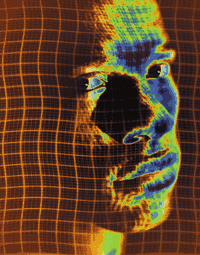.: Click here to download :.
The field of biometrics involves identifying people by measuring parts of their bodies. It now promises to find wide
acceptance as a convenient and secure alternative to typed passwords, mechanical keys, or written signatures for access
to computers, facilities or vehicles, and identification for financial transactions. Personal access control systems
have been implemented using visual recognition for identification of individuals. Visual recognition systems use
characteristic portions of the human body for identification purposes. Typical of this type of access control are
face recognition systems and fingerprint recognition systems. Face recognition systems essentially operate by
comparing some type of model image of a person's face (or representation thereof) to an image or representation of the
person's face extracted from an input image. Image recognition, and particularly face recognition, is becoming an
increasingly popular feature in a variety of applications. Face recognition applications can be used by security
agencies, law enforcement agencies, the airline industry, the border patrol, the banking and securities industries
and the like. Examples of potential applications include entry control to limited access areas, access to computer
equipment, access to automatic teller terminals, identification of individuals and the like. In particular, security
systems use face recognition to grant or deny access to select individuals, or to sound an alarm when a particular
person is recognized, or to continually track an individual as the individual travels amongst a plurality of people,
and so on. In like manner, home automation systems are being configured to distinguish among residents of a home,
so that the features of the system can be customized for each resident.
We have developed a semi-automatic approach for one-to-one face matching that is capable to recognize
an unknow input facial image. User has to manually select some fiducial points and within a fraction of a second a
unique facecode is generated. Such binary code uniquely identifies a person.
Index Terms: Matlab, source, code, face, identification, one-to-one, 1:1, authentication, recognition, CPD, semi-automatic.
 |
Figure 1. Fiducial points |
||||||||||||||
|
A simple and effective source code for Face Identification System. |
|||||||||||||||
Demo code (protected
P-files) available for performance evaluation. Matlab Image Processing Toolbox and Matlab Signal Processing Toolbox are required.
|
|||||||||||||||
|
Release |
Date |
Major features |
|||||||||||||
|
1.0 |
2009.07.29 |
|
|||||||||||||
We recommend to check the secure connection to PayPal, in order to avoid any fraud. This donation has to be considered an encouragement to improve the code itself. |
|||||||||||||||
Face Identification System. Click here for
your donation. In order to obtain the source code you
have to pay a little sum of money: 150 EUROS (less
than 210 U.S. Dollars). |
|||||||||||||||
Once you have done this, please email us luigi.rosa@tiscali.it As soon as possible (in a few days) you will receive our new release of Face Identification System. Alternatively, you can bestow using our banking coordinates:
|
|||||||||||||||
The authors have no relationship or partnership
with The Mathworks. All the code provided is written in Matlab
language (M-files and/or M-functions), with no dll or other
protected parts of code (P-files or executables). The code was
developed with Matlab 2006a. Matlab Image Processing Toolbox and Matlab Signal Processing Toolbox are required.
The code provided has to be considered "as is" and it is without any kind of warranty. The
authors deny any kind of warranty concerning the code as well
as any kind of responsibility for problems and damages which may
be caused by the use of the code itself including all parts of
the source code.

